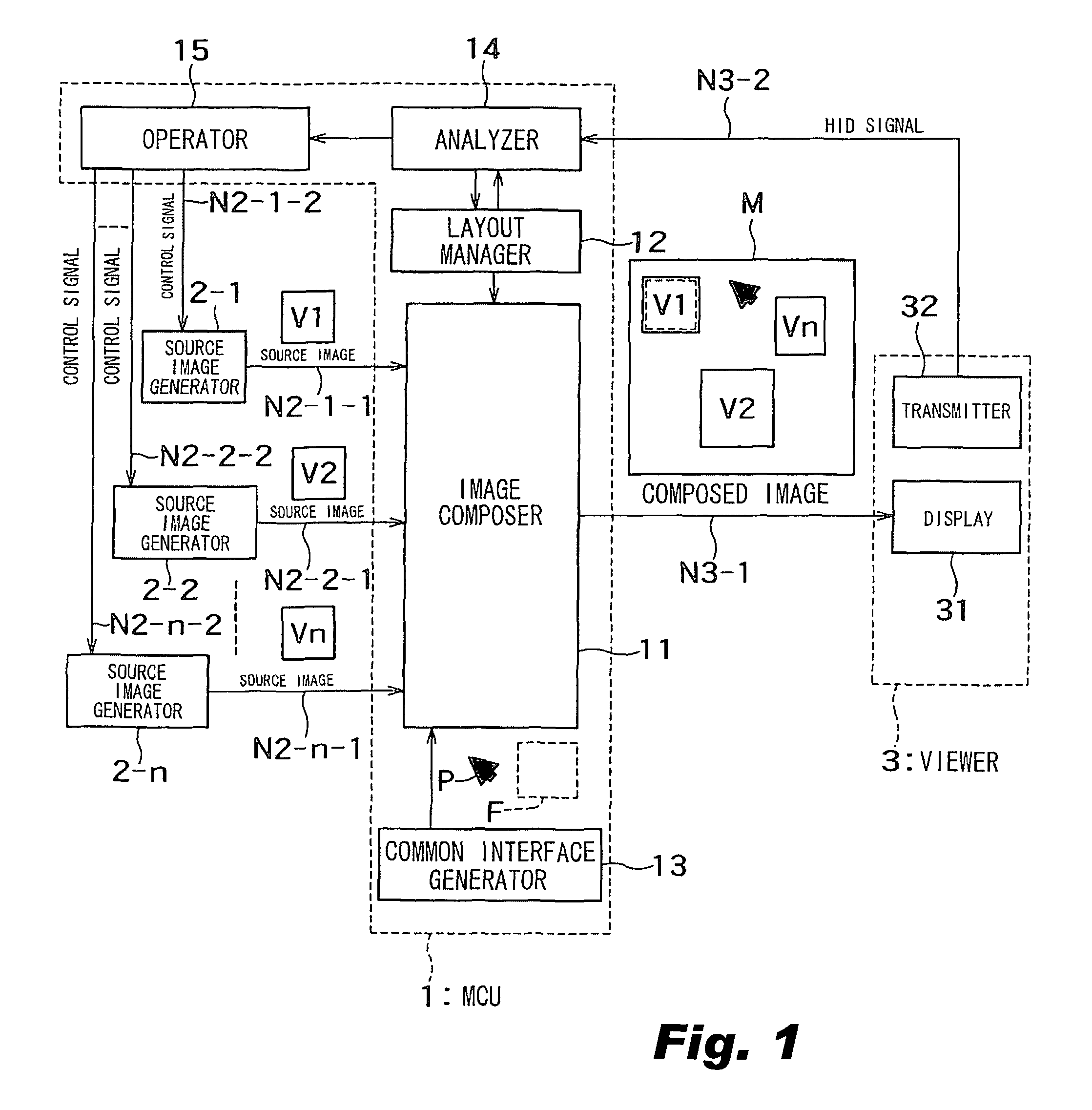Image control from composed composite image using HID signal conversion to source image coordinates
a composite image and source image technology, applied in the direction of electric digital data processing, instruments, computing, etc., can solve the problems of reducing the size of objects in the source image on the composed image, and affecting the display of terminal-viewer displays,
- Summary
- Abstract
- Description
- Claims
- Application Information
AI Technical Summary
Benefits of technology
Problems solved by technology
Method used
Image
Examples
first exemplary embodiment
[0049]FIG. 1 illustrates a diagram of an example of a first non-limiting embodiment of a remote-control system.
[0050]A remote-control system includes a plurality of source image generators (numbered from 2-1 to 2-n), a viewer 3, and MCU 1 which communicate with each other through network paths as shown.
[0051]Source image generators 2-1 and 2-n can be controlled from a remote location through a network. Source image generators 2-1 to 2-n may be PCs. Source image generator 2-1 transmit a source image V1 with a source ID “V1” to MCU 1 through network path N2-1-1. In this embodiment, source image generator 2-1 treats a specification of source image V1 as a normalized value such as 100 percent for each of a horizontal direction x and a vertical direction y shown in FIG. 2(a) as coordinate system 200.
[0052]Source image generator 2-1 controls pointer P on a source image according to a control signal sent from MCU 1. Moreover, source image generator 2-1 detects an event based on the positio...
second embodiment
[0083]An example of a second non-limiting embodiment of a remote-control system is described using FIGS. 21(a) to FIG. 26 (supplementing to the FIGURES described above).
[0084]FIG. 21(a) is an example of layout information stored as layout management table in layout manager 12 in this embodiment. The layout management table has parameters (x′, y′, w′, h′) in addition to the layout management table described in the first embodiment. Those parameters (x′, y′, w′, h′) indicate an operative area.
[0085]The operative area indicates an area to be sent independently of MCU 1. That is, an image in the defined operative area is shown independently on the composed image displayed by viewer 3. In FIG. 21(b), a broken rectangle indicates the operative area. The parameters (x′, y′, w′, h′) are initialized as (0, 0, 100, 100) that indicates the operative area covers all the source image. When the parameters are the initial values, an image in the operative area may not be sent independently of MCU ...
third embodiment
[0098]An example of a third non-limiting embodiment of a remote-control system is described using FIG. 27 to FIG. 29 (supplementing the FIGURES described above).
[0099]FIG. 27 illustrates a schematic diagram of an exemplary third non-limiting embodiment of a remote-control system. In this embodiment, common interface generator 13 uses the control signal, and common interface generator 13 outputs common interface control signals to operator 15. FIG. 28(a) and FIG. 28(b) illustrate composed image M including an image of a software keyboard SK. In FIG. 28(b), the software keyboard SK adjoins source image V1. The image of software keyboard SK includes a plurality of keys.
[0100]If the user controls pointer P onto a key of the software keyboard SK with the mouse and clicks the right button, an HID signal is sent from transmitter 32 of viewer 3 to analyzer 14 of MCU 1. Analyzer 14 analyzes the HID signal sent from viewer 3 and outputs the results of the analysis (e.g., such as the pointer's...
PUM
 Login to View More
Login to View More Abstract
Description
Claims
Application Information
 Login to View More
Login to View More - R&D
- Intellectual Property
- Life Sciences
- Materials
- Tech Scout
- Unparalleled Data Quality
- Higher Quality Content
- 60% Fewer Hallucinations
Browse by: Latest US Patents, China's latest patents, Technical Efficacy Thesaurus, Application Domain, Technology Topic, Popular Technical Reports.
© 2025 PatSnap. All rights reserved.Legal|Privacy policy|Modern Slavery Act Transparency Statement|Sitemap|About US| Contact US: help@patsnap.com



